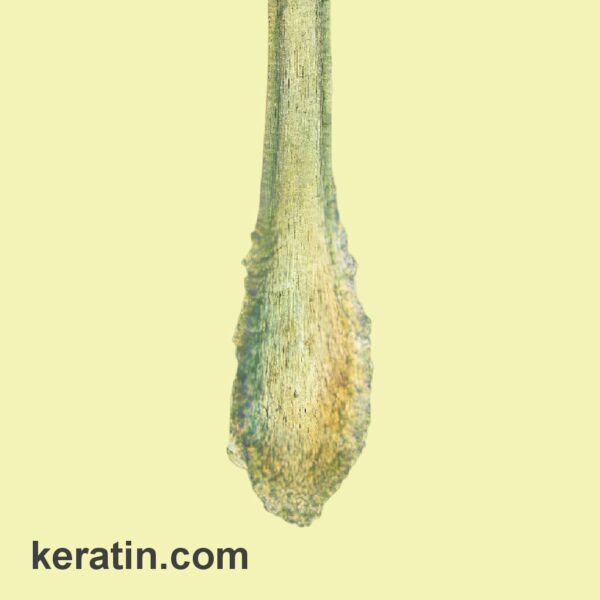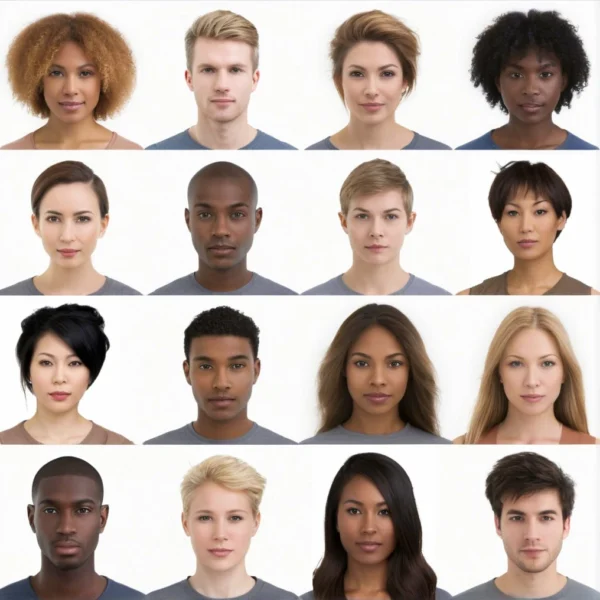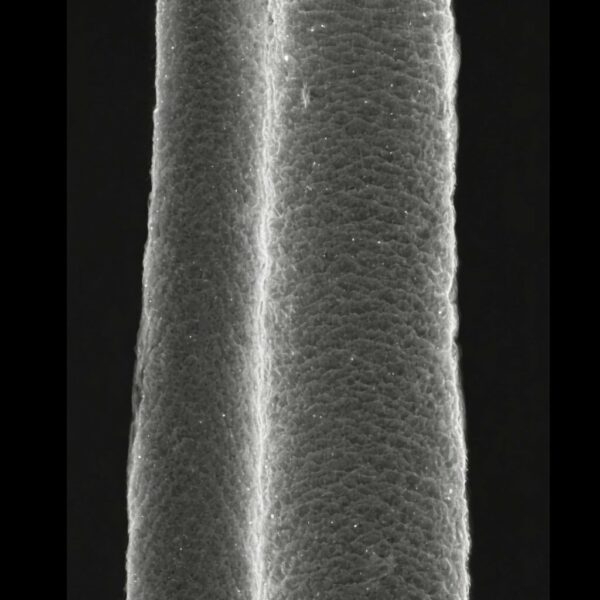Hair growth is a complex, cyclic process that involves several phases: anagen (growth phase), catagen (transitional phase), and telogen (resting phase). Club hairs are a characteristic feature of the telogen phase, signaling the end of active hair growth. Understanding club hairs is important for professionals in dermatology, trichology, and related fields, as club hairs can play a significant role in diagnosing and managing hair and scalp conditions.
The Hair Growth Cycle and Formation of Club Hairs: To comprehend the occurrence of club hairs, it’s useful to first understand the hair growth cycle, which consists of three main phases:
Anagen Phase : The anagen phase is the period of active hair growth, lasting several years on the scalp. During this phase, cells in the root of the hair are dividing rapidly, adding to the hair shaft.Catagen Phase : Following the anagen phase, the hair enters the catagen phase, a transitional period that lasts about two to three weeks. In this phase, the hair follicle in the skin shrinks in size, and hair growth stops. The base of the hair is pushed upwards towards the scalp as the follicle regresses and progressively enters a dormant state.Telogen Phase : Finally, the hair enters the telogen phase, a resting period that lasts around three months for human scalp hair. During this phase, the hair follicle is completely at rest, and the hair, now a “club hair,” is not growing.Club hairs are formed during the telogen phase when the hair shaft’s lower part becomes keratinized and hardens. This process results in the characteristic bulb or “club” shape at the hair’s root. As a hair follicle enters a resting stage it stops producing new cells for incorporation into the hair fiber. The remaining cortex cells in the hair root have to be removed for the hair follicle to enter a true resting state. These remaining cells are attached to the end of the hair fiber as a keratinized lump or a club shape. The presence of a club-shaped end is a sign that the hair has completed its growth cycle and is ready to shed.
The club shape does serve a purpose. It is wider size than the rest of the normal hair fiber and so it acts as a wedge to help hold the hair in place in the hair follicle canal. Although the fiber is no longer growing and the hair follicle below it resting, the club hair does not immediately fall out of the follicle. There is also some evidence that an active process helps anchor the club hair in the hair follicle during the early telogen phase. As time goes on, this anchoring activity gets weaker. The club hair can be pulled out during washing, combing, brushing, styling or any other form of physical hair manipulation, but often the club hair stays in place until the hair follicle below it returns to an active state and starts making a new hair fiber. The new fiber eventually pushes the old club fiber out of the hair follicle.
Significance of Club Hairs: The presence of club hairs is a natural and healthy part of the hair renewal process. Typically, it’s normal to shed 50-100 scalp hairs a day, most of which are club hairs. This shedding is generally unnoticed, but it is a vital aspect of maintaining hair health and density.
In the context of hair and scalp health, the examination of shed hairs for club ends can provide valuable insights. A higher than normal proportion of club hairs can indicate that a significant number of hairs have entered the telogen phase simultaneously, a condition known as “telogen effluvium”. This condition can be triggered by various factors, including stress, nutritional deficiencies, hormonal changes, or medical conditions.
Conversely, if there is a lack of club hairs observed among shed hairs, this might suggest a problem with the hair growth cycle, such as “anagen effluvium”. An anagen effluvium is where hairs fall out during the growth phase. This condition can be caused by chemotherapy, radiation therapy, or certain illnesses and can lead to significant hair loss.
Clinical and Research Implications: For professionals working in dermatology and trichology, understanding the dynamics of club hair formation is crucial for diagnosing and treating hair loss conditions. Assessing the proportion of club hairs that are shed can help differentiate between various forms of hair loss and guide appropriate treatment strategies.
In research, the study of club hairs and their formation can provide insights into the underlying mechanisms of hair growth and loss. For scientists focused on hair and skin disease research, exploring the molecular and cellular events that lead to the formation of club hairs can contribute to the development of new therapies and interventions for hair loss conditions.
Conclusion: Club hairs play a crucial role in the natural hair growth cycle, marking the transition of hair follicles from active hair fiber growth to shedding. Their presence and proportion can serve as indicators of scalp health and the dynamics of hair follicle activity. For researchers and healthcare professionals, understanding club hairs is helpful for diagnosing hair loss conditions and developing effective treatments. As research continues to unravel the complexities of hair growth and renewal, the study of club hairs remains a vital area of focus, offering potential pathways to innovative solutions for hair and scalp disorders.
Bibliography
11711645 {11711645:ENKEDN75},{11711645:44PI5Q8J},{11711645:EH3DCR9K},{11711645:EDCVCRDS},{11711645:JFSHJCM6},{11711645:2AVX6TA2},{11711645:GMGRRZF6},{11711645:V6MUJTND},{11711645:9I863KUR},{11711645:6FV6RZVV},{11711645:KQA67CSH} 1 vancouver 50 date asc 1177 https://www.keratin.com/wp-content/plugins/zotpress/ %7B%22status%22%3A%22success%22%2C%22updateneeded%22%3Afalse%2C%22instance%22%3Afalse%2C%22meta%22%3A%7B%22request_last%22%3A0%2C%22request_next%22%3A0%2C%22used_cache%22%3Atrue%7D%2C%22data%22%3A%5B%7B%22key%22%3A%2244PI5Q8J%22%2C%22library%22%3A%7B%22id%22%3A11711645%7D%2C%22meta%22%3A%7B%22creatorSummary%22%3A%22Ebling%22%2C%22parsedDate%22%3A%221987-07%22%2C%22numChildren%22%3A0%7D%2C%22bib%22%3A%22%3Cdiv%20class%3D%5C%22csl-bib-body%5C%22%20style%3D%5C%22line-height%3A%201.35%3B%20%5C%22%3E%5Cn%20%20%3Cdiv%20class%3D%5C%22csl-entry%5C%22%20style%3D%5C%22clear%3A%20left%3B%20%5C%22%3E%5Cn%20%20%20%20%3Cdiv%20class%3D%5C%22csl-left-margin%5C%22%20style%3D%5C%22float%3A%20left%3B%20padding-right%3A%200.5em%3B%20text-align%3A%20right%3B%20width%3A%201em%3B%5C%22%3E1.%3C%5C%2Fdiv%3E%3Cdiv%20class%3D%5C%22csl-right-inline%5C%22%20style%3D%5C%22margin%3A%200%20.4em%200%201.5em%3B%5C%22%3EEbling%20FJ.%20The%20biology%20of%20hair.%20Dermatol%20Clin.%201987%20Jul%3B5%283%29%3A467%26%23x2013%3B81.%3C%5C%2Fdiv%3E%5Cn%20%20%20%3C%5C%2Fdiv%3E%5Cn%3C%5C%2Fdiv%3E%22%2C%22data%22%3A%7B%22itemType%22%3A%22journalArticle%22%2C%22title%22%3A%22The%20biology%20of%20hair%22%2C%22creators%22%3A%5B%7B%22creatorType%22%3A%22author%22%2C%22firstName%22%3A%22F.%20J.%22%2C%22lastName%22%3A%22Ebling%22%7D%5D%2C%22abstractNote%22%3A%22Hair%20is%20a%20product%20of%20small%20pits%20in%20the%20skin%20known%20as%20hair%20follicles.%20The%20most%20important%20feature%20of%20hair%20follicles%20is%20that%20their%20activity%20is%20intermittent%3B%20each%20active%20phase%20or%20anagen%20is%20succeeded%20by%20a%20transitional%20phase%20%28catagen%29%20and%20a%20resting%20phase%20%28telogen%29%2C%20during%20which%20the%20fully%20formed%20%5C%22club%20hair%5C%22%20is%20retained%20for%20a%20period%20and%20then%20shed.%20The%20growth%20of%20facial%2C%20body%2C%20axillary%2C%20and%20pubic%20hair%20depends%20on%20androgens.%20Facial%20hair%20and%20body%20hair%20require%20high%20levels%20of%20testosterone%20and%20its%20conversion%20to%205-alpha-dihydrotestosterone.%20Pubic%20and%20axillary%20hair%20follicles%20require%20much%20lower%20levels%20of%20hormone%2C%20and%205-alpha-reduction%20appears%20to%20be%20unnecessary.%20Paradoxically%2C%20male%20pattern%20alopecia%20and%20its%20female%20equivalent%20also%20require%20androgen%20for%20their%20manifestation.%20The%20differing%20lengths%20of%20hair%20in%20the%20various%20regions%20of%20the%20body%20result%20largely%20from%20differences%20in%20the%20duration%20of%20anagen%20and%20only%20to%20a%20small%20extent%20from%20differences%20in%20the%20rates%20of%20growth.%20Some%20hair%20loss%20from%20the%20scalp%20can%20be%20characterized%20in%20terms%20of%20the%20hair%20growth%20cycle%2C%20and%20some%20involves%20long-term%20changes%20in%20the%20follicular%20architecture.%20Thus%20postfebrile%20and%20postpartum%20alopecias%20are%20telogen%20effluvia%20that%20involve%20shedding%20of%20club%20hairs%2C%20whereas%20drug-induced%20alopecia%20and%20alopecia%20areata%20involve%20shearing%20and%20loss%20of%20growing%20hairs.%20Male%20pattern%20baldness%20and%20female%20diffuse%20alopecia%20involve%20gradual%20shortening%20of%20the%20periods%20of%20anagen%20and%20shrinkage%20of%20the%20hair%20follicles%20over%20a%20long%20term.%22%2C%22date%22%3A%221987-07%22%2C%22language%22%3A%22eng%22%2C%22DOI%22%3A%22%22%2C%22ISSN%22%3A%220733-8635%22%2C%22url%22%3A%22%22%2C%22collections%22%3A%5B%22AATM4CJP%22%5D%2C%22dateModified%22%3A%222024-02-10T14%3A19%3A25Z%22%7D%7D%2C%7B%22key%22%3A%229I863KUR%22%2C%22library%22%3A%7B%22id%22%3A11711645%7D%2C%22meta%22%3A%7B%22creatorSummary%22%3A%22Sperling%22%2C%22parsedDate%22%3A%221991-07%22%2C%22numChildren%22%3A0%7D%2C%22bib%22%3A%22%3Cdiv%20class%3D%5C%22csl-bib-body%5C%22%20style%3D%5C%22line-height%3A%201.35%3B%20%5C%22%3E%5Cn%20%20%3Cdiv%20class%3D%5C%22csl-entry%5C%22%20style%3D%5C%22clear%3A%20left%3B%20%5C%22%3E%5Cn%20%20%20%20%3Cdiv%20class%3D%5C%22csl-left-margin%5C%22%20style%3D%5C%22float%3A%20left%3B%20padding-right%3A%200.5em%3B%20text-align%3A%20right%3B%20width%3A%201em%3B%5C%22%3E1.%3C%5C%2Fdiv%3E%3Cdiv%20class%3D%5C%22csl-right-inline%5C%22%20style%3D%5C%22margin%3A%200%20.4em%200%201.5em%3B%5C%22%3ESperling%20LC.%20Hair%20anatomy%20for%20the%20clinician.%20J%20Am%20Acad%20Dermatol.%201991%20Jul%3B25%281%20Pt%201%29%3A1%26%23x2013%3B17.%3C%5C%2Fdiv%3E%5Cn%20%20%20%3C%5C%2Fdiv%3E%5Cn%3C%5C%2Fdiv%3E%22%2C%22data%22%3A%7B%22itemType%22%3A%22journalArticle%22%2C%22title%22%3A%22Hair%20anatomy%20for%20the%20clinician%22%2C%22creators%22%3A%5B%7B%22creatorType%22%3A%22author%22%2C%22firstName%22%3A%22L.%20C.%22%2C%22lastName%22%3A%22Sperling%22%7D%5D%2C%22abstractNote%22%3A%22The%20rational%20evaluation%20of%20hair%20disorders%20requires%20familiarity%20with%20follicular%20anatomy.%20Hair%20structure%20can%20be%20easily%20examined%20by%20studying%20clipped%20hair%20shafts%2C%20entire%20hairs%20gently%20pulled%20or%20forcibly%20plucked%20from%20the%20scalp%2C%20and%20scalp%20biopsies%20%28sectioned%20vertically%20or%20transversely%29.%20Anatomic%20features%20will%20be%20different%20depending%20on%20whether%20a%20given%20hair%20is%20in%20the%20anagen%2C%20catagen%2C%20or%20telogen%20phase.%20Follicle%20size%20will%20also%20vary%2C%20from%20the%20minute%20vellus%20hair%20to%20the%20long%2C%20thick%20terminal%20hair.%20Each%20follicle%20can%20be%20divided%20into%20distinct%20regions--bulb%2C%20suprabulbar%20zone%2C%20isthmus%2C%20and%20infundibulum.%20Activity%20growing%20%28anagen%29%20hairs%20are%20characterized%20by%20a%20hair%20matrix%20surrounding%20a%20dermal%20papilla%3B%20inner%20and%20outer%20root%20sheaths%20are%20present%20and%20well%20developed.%20A%20catagen%20hair%20can%20be%20identified%20by%20its%20markedly%20thickened%20vitreous%20layer%20and%20fibrous%20root%20sheath%2C%20which%20surrounds%20an%20epithelial%20column%3B%20above%20this%20column%2C%20the%20presumptive%20club%20forms.%20A%20telogen%20hair%20is%20distinguished%20by%20its%20fully%20keratinized%20club%2C%20which%20is%20surrounded%20by%20an%20epithelial%20sac.%20Below%20this%20lies%20the%20secondary%20hair%20germ%20and%20condensed%20dermal%20papilla%2C%20waiting%20for%20the%20mysterious%20signal%20that%20initiates%20a%20new%20life%20cycle.%22%2C%22date%22%3A%221991-07%22%2C%22language%22%3A%22eng%22%2C%22DOI%22%3A%2210.1016%5C%2F0190-9622%2891%2970167-z%22%2C%22ISSN%22%3A%220190-9622%22%2C%22url%22%3A%22%22%2C%22collections%22%3A%5B%22AATM4CJP%22%5D%2C%22dateModified%22%3A%222024-02-10T14%3A16%3A09Z%22%7D%7D%2C%7B%22key%22%3A%22EDCVCRDS%22%2C%22library%22%3A%7B%22id%22%3A11711645%7D%2C%22meta%22%3A%7B%22creatorSummary%22%3A%22Headington%22%2C%22parsedDate%22%3A%221993-03%22%2C%22numChildren%22%3A0%7D%2C%22bib%22%3A%22%3Cdiv%20class%3D%5C%22csl-bib-body%5C%22%20style%3D%5C%22line-height%3A%201.35%3B%20%5C%22%3E%5Cn%20%20%3Cdiv%20class%3D%5C%22csl-entry%5C%22%20style%3D%5C%22clear%3A%20left%3B%20%5C%22%3E%5Cn%20%20%20%20%3Cdiv%20class%3D%5C%22csl-left-margin%5C%22%20style%3D%5C%22float%3A%20left%3B%20padding-right%3A%200.5em%3B%20text-align%3A%20right%3B%20width%3A%201em%3B%5C%22%3E1.%3C%5C%2Fdiv%3E%3Cdiv%20class%3D%5C%22csl-right-inline%5C%22%20style%3D%5C%22margin%3A%200%20.4em%200%201.5em%3B%5C%22%3EHeadington%20JT.%20Telogen%20effluvium.%20New%20concepts%20and%20review.%20Arch%20Dermatol.%201993%20Mar%3B129%283%29%3A356%26%23x2013%3B63.%3C%5C%2Fdiv%3E%5Cn%20%20%20%3C%5C%2Fdiv%3E%5Cn%3C%5C%2Fdiv%3E%22%2C%22data%22%3A%7B%22itemType%22%3A%22journalArticle%22%2C%22title%22%3A%22Telogen%20effluvium.%20New%20concepts%20and%20review%22%2C%22creators%22%3A%5B%7B%22creatorType%22%3A%22author%22%2C%22firstName%22%3A%22J.%20T.%22%2C%22lastName%22%3A%22Headington%22%7D%5D%2C%22abstractNote%22%3A%22BACKGROUND%3A%20Telogen%20effluvium%20is%20the%20result%20of%20a%20perturbation%20of%20the%20hair%20cycle%20that%20is%20manifest%20by%20increased%20loss%20of%20normal%20club%20hairs.%20Although%20diverse%20causes%20for%20telogen%20effluvium%20have%20been%20proposed%2C%20this%20article%20suggests%20several%20diverse%20mechanisms%20for%20the%20first%20time.%5CnOBSERVATIONS%3A%20Five%20different%20functional%20types%20of%20telogen%20effluvia%20are%20proposed%20based%20on%20changes%20in%20different%20phases%20of%20the%20follicular%20cycle.%20These%20are%20immediate%20anagen%20release%2C%20delayed%20anagen%20release%2C%20short%20anagen%20syndrome%2C%20immediate%20telogen%20release%2C%20and%20delayed%20telogen%20release.%20Diverse%20causes%20are%20confirmed%20and%20drug-related%20telogen%20effluvia%20are%20reviewed.%5CnCONCLUSIONS%3A%20The%20five%20diverse%20mechanisms%20proposed%20for%20telogen%20effluvia%20are%20generally%20confirmed%20and%20supported%20by%20clinical%20findings.%22%2C%22date%22%3A%221993-03%22%2C%22language%22%3A%22eng%22%2C%22DOI%22%3A%2210.1001%5C%2Farchderm.129.3.356%22%2C%22ISSN%22%3A%220003-987X%22%2C%22url%22%3A%22%22%2C%22collections%22%3A%5B%22AATM4CJP%22%5D%2C%22dateModified%22%3A%222024-02-10T14%3A15%3A42Z%22%7D%7D%2C%7B%22key%22%3A%22ENKEDN75%22%2C%22library%22%3A%7B%22id%22%3A11711645%7D%2C%22meta%22%3A%7B%22creatorSummary%22%3A%22Camidge%20et%20al.%22%2C%22parsedDate%22%3A%222005-05-23%22%2C%22numChildren%22%3A0%7D%2C%22bib%22%3A%22%3Cdiv%20class%3D%5C%22csl-bib-body%5C%22%20style%3D%5C%22line-height%3A%201.35%3B%20%5C%22%3E%5Cn%20%20%3Cdiv%20class%3D%5C%22csl-entry%5C%22%20style%3D%5C%22clear%3A%20left%3B%20%5C%22%3E%5Cn%20%20%20%20%3Cdiv%20class%3D%5C%22csl-left-margin%5C%22%20style%3D%5C%22float%3A%20left%3B%20padding-right%3A%200.5em%3B%20text-align%3A%20right%3B%20width%3A%201em%3B%5C%22%3E1.%3C%5C%2Fdiv%3E%3Cdiv%20class%3D%5C%22csl-right-inline%5C%22%20style%3D%5C%22margin%3A%200%20.4em%200%201.5em%3B%5C%22%3ECamidge%20DR%2C%20Randall%20KR%2C%20Foster%20JR%2C%20Sadler%20CJ%2C%20Wright%20JA%2C%20Soames%20AR%2C%20et%20al.%20Plucked%20human%20hair%20as%20a%20tissue%20in%20which%20to%20assess%20pharmacodynamic%20end%20points%20during%20drug%20development%20studies.%20Br%20J%20Cancer.%202005%20May%2023%3B92%2810%29%3A1837%26%23x2013%3B41.%3C%5C%2Fdiv%3E%5Cn%20%20%20%3C%5C%2Fdiv%3E%5Cn%3C%5C%2Fdiv%3E%22%2C%22data%22%3A%7B%22itemType%22%3A%22journalArticle%22%2C%22title%22%3A%22Plucked%20human%20hair%20as%20a%20tissue%20in%20which%20to%20assess%20pharmacodynamic%20end%20points%20during%20drug%20development%20studies%22%2C%22creators%22%3A%5B%7B%22creatorType%22%3A%22author%22%2C%22firstName%22%3A%22D.%20R.%22%2C%22lastName%22%3A%22Camidge%22%7D%2C%7B%22creatorType%22%3A%22author%22%2C%22firstName%22%3A%22K.%20R.%22%2C%22lastName%22%3A%22Randall%22%7D%2C%7B%22creatorType%22%3A%22author%22%2C%22firstName%22%3A%22J.%20R.%22%2C%22lastName%22%3A%22Foster%22%7D%2C%7B%22creatorType%22%3A%22author%22%2C%22firstName%22%3A%22C.%20J.%22%2C%22lastName%22%3A%22Sadler%22%7D%2C%7B%22creatorType%22%3A%22author%22%2C%22firstName%22%3A%22J.%20A.%22%2C%22lastName%22%3A%22Wright%22%7D%2C%7B%22creatorType%22%3A%22author%22%2C%22firstName%22%3A%22A.%20R.%22%2C%22lastName%22%3A%22Soames%22%7D%2C%7B%22creatorType%22%3A%22author%22%2C%22firstName%22%3A%22P.%20J.%22%2C%22lastName%22%3A%22Laud%22%7D%2C%7B%22creatorType%22%3A%22author%22%2C%22firstName%22%3A%22P.%20D.%22%2C%22lastName%22%3A%22Smith%22%7D%2C%7B%22creatorType%22%3A%22author%22%2C%22firstName%22%3A%22A.%20M.%22%2C%22lastName%22%3A%22Hughes%22%7D%5D%2C%22abstractNote%22%3A%22We%20have%20demonstrated%20the%20feasibility%20of%20detecting%20and%20quantifying%20six%20cell-cycle-related%20nuclear%20markers%20%28Ki67%2C%20pRb%2C%20p27%2C%20phospho-p27%20%28phosphorylated%20p27%29%2C%20phospho-pRb%20%28phosphorylated%20pRb%29%2C%20phospho-HH3%20%28phosphorylated%20histone%20H3%29%29%20in%20plucked%20human%20scalp%20and%20eyebrow%20hair.%20Estimates%20of%20the%20proportion%20of%20plucked%20hairs%20that%20are%20lost%20or%20damaged%20during%20processing%20plus%20the%20intra-%20and%20intersubject%20variability%20of%20each%20nuclear%20marker%20with%20these%20techniques%20are%20provided%20to%20inform%20sizing%20decisions%20for%20intervention%20studies%20with%20drugs%20potentially%20impacting%20on%20these%20markers%20in%20the%20future.%22%2C%22date%22%3A%222005-05-23%22%2C%22language%22%3A%22eng%22%2C%22DOI%22%3A%2210.1038%5C%2Fsj.bjc.6602558%22%2C%22ISSN%22%3A%220007-0920%22%2C%22url%22%3A%22%22%2C%22collections%22%3A%5B%22AATM4CJP%22%5D%2C%22dateModified%22%3A%222024-02-10T14%3A25%3A44Z%22%7D%7D%2C%7B%22key%22%3A%226FV6RZVV%22%2C%22library%22%3A%7B%22id%22%3A11711645%7D%2C%22meta%22%3A%7B%22creatorSummary%22%3A%22Van%20Neste%22%2C%22parsedDate%22%3A%222006%22%2C%22numChildren%22%3A0%7D%2C%22bib%22%3A%22%3Cdiv%20class%3D%5C%22csl-bib-body%5C%22%20style%3D%5C%22line-height%3A%201.35%3B%20%5C%22%3E%5Cn%20%20%3Cdiv%20class%3D%5C%22csl-entry%5C%22%20style%3D%5C%22clear%3A%20left%3B%20%5C%22%3E%5Cn%20%20%20%20%3Cdiv%20class%3D%5C%22csl-left-margin%5C%22%20style%3D%5C%22float%3A%20left%3B%20padding-right%3A%200.5em%3B%20text-align%3A%20right%3B%20width%3A%201em%3B%5C%22%3E1.%3C%5C%2Fdiv%3E%3Cdiv%20class%3D%5C%22csl-right-inline%5C%22%20style%3D%5C%22margin%3A%200%20.4em%200%201.5em%3B%5C%22%3EVan%20Neste%20D.%20Natural%20scalp%20hair%20regression%20in%20preclinical%20stages%20of%20male%20androgenetic%20alopecia%20and%20its%20reversal%20by%20finasteride.%20Skin%20Pharmacol%20Physiol.%202006%3B19%283%29%3A168%26%23x2013%3B76.%3C%5C%2Fdiv%3E%5Cn%20%20%20%3C%5C%2Fdiv%3E%5Cn%3C%5C%2Fdiv%3E%22%2C%22data%22%3A%7B%22itemType%22%3A%22journalArticle%22%2C%22title%22%3A%22Natural%20scalp%20hair%20regression%20in%20preclinical%20stages%20of%20male%20androgenetic%20alopecia%20and%20its%20reversal%20by%20finasteride%22%2C%22creators%22%3A%5B%7B%22creatorType%22%3A%22author%22%2C%22firstName%22%3A%22D.%22%2C%22lastName%22%3A%22Van%20Neste%22%7D%5D%2C%22abstractNote%22%3A%22Using%20contrast-enhanced%20phototrichogram%20%28CE-PTG%29%20at%20monthly%20intervals%20during%2048%20months%2C%20we%20measured%20the%20duration%20of%20the%20hair%20cycle%2C%20i.e.%20anagen%2C%20catagen%20and%20telogen%20at%20the%20exclusion%20of%20exogen.%20Exogen%2C%20a%20recently%20identified%20phase%20of%20the%20hair%20cycle%2C%20is%20characterized%20by%20weakening%20of%20anchorage%20of%20the%20club%20hair%20to%20the%20surrounding%20epithelium.%20The%20processing%20of%20the%20club%20hair%20terminates%20at%20the%20time%20of%20exogen%20hair%20release%2C%20i.e.%20hair%20shedding.%20We%20combined%20a%20noninvasive%20exogen%20sampling%20before%20each%20CE-PTG%20so%20that%20the%20area%20contained%20only%20anagen%2C%20catagen%20and%20telogen%20hair%20or%20empty%20follicular%20openings.%20During%20the%20first%2024%20months%20of%20this%20study%2C%20natural%20regression%20of%20hair%20cycling%20in%20early%20i.e.%20preclinical%20stages%20of%20androgenetic%20alopecia%20%28AGA%29%20in%20androgen%20sensitive%20areas%20was%20documented.%20Shortening%20of%20the%20hair%20cycle%20of%20thicker%20hair%20characterized%20progression%20of%20AGA.%20During%20the%20next%2024%20months%2C%20finasteride%20%281%20mg%5C%2Fday%29%20was%20introduced%20into%20the%20system.%20Shortening%20of%20the%20hair%20cycle%20was%20reversed%20by%20finasteride%20in%20androgen%20sensitive%20sites%20as%20long%20as%20the%20affected%20follicle%20was%20able%20to%20produce%20a%20thick%20hair%20fiber%20at%20the%20time%20of%20treatment%20initiation.%20Compared%20to%20the%20baseline%20period%2C%20responding%20follicles%20did%20not%20produce%20thicker%20hair.%20On%20average%2C%20they%20initiated%20active%20growth%20more%20rapidly%20by%20reducing%20the%20duration%20of%20the%20lag%20phase%20by%2040%25.%20The%20duration%20of%20the%20anagen%20phase%20of%20thick%20hair%20showed%20an%20average%2023%25%20increase.%20In%20this%20particular%20experiment%2C%20the%20already%20miniaturized%20follicles%20producing%20thinner%20hair%20%28%3C40%20microm%20thickness%29%20at%20the%20time%20of%20finasteride%20introduction%20regressed%20further%20on%20treatment.%20Our%20results%20seem%20to%20indicate%20that%20reversal%20of%20%27hair%20loss%27%20by%20finasteride%20probably%20means%20that%20the%20terminal%20type%20follicles%20that%20are%20functionally%20deficient--a%20stage%20of%20reversible%20hypotrophy--will%20be%20reactivated%20by%20two%20non-mutually%20exclusive%20mechanisms%3A%20faster%20regrowth%20followed%20by%20extension%20of%20the%20duration%20of%20anagen.%20In%20our%20study%2C%20there%20was%20no%20clear%20evidence%20in%20favour%20of%20reversal%20of%20miniaturized%20hair%20into%20terminal%20hair.%20This%20new%20interpretation%20indicates%20that%20miniaturized%20hair%20follicles%20may%20be%20an%20important%20diagnostic%20marker%20of%20AGA%20in%20males%20but%20also%20that%20it%20might%20be%20less%20contributive%20to%20the%20therapeutic%20response%20to%20finasteride.%20Our%20results%20highlight%20that%20precise%20measurement%20of%20terminal%20type%20hair%20follicle%20functionalities%20opens%20up%20avenues%20for%20the%20selection%20of%20%27drug-responsive%20organs%27%20in%20the%20human%20scalp%20in%20vivo%20and%20these%20may%20possibly%20serve%20to%20predict%20%27quality%20of%20response%20to%20treatment%27.%22%2C%22date%22%3A%222006%22%2C%22language%22%3A%22eng%22%2C%22DOI%22%3A%2210.1159%5C%2F000093051%22%2C%22ISSN%22%3A%221660-5527%22%2C%22url%22%3A%22%22%2C%22collections%22%3A%5B%22AATM4CJP%22%5D%2C%22dateModified%22%3A%222024-02-10T14%3A28%3A58Z%22%7D%7D%2C%7B%22key%22%3A%22KQA67CSH%22%2C%22library%22%3A%7B%22id%22%3A11711645%7D%2C%22meta%22%3A%7B%22creatorSummary%22%3A%22Van%20Neste%20et%20al.%22%2C%22parsedDate%22%3A%222007-11%22%2C%22numChildren%22%3A0%7D%2C%22bib%22%3A%22%3Cdiv%20class%3D%5C%22csl-bib-body%5C%22%20style%3D%5C%22line-height%3A%201.35%3B%20%5C%22%3E%5Cn%20%20%3Cdiv%20class%3D%5C%22csl-entry%5C%22%20style%3D%5C%22clear%3A%20left%3B%20%5C%22%3E%5Cn%20%20%20%20%3Cdiv%20class%3D%5C%22csl-left-margin%5C%22%20style%3D%5C%22float%3A%20left%3B%20padding-right%3A%200.5em%3B%20text-align%3A%20right%3B%20width%3A%201em%3B%5C%22%3E1.%3C%5C%2Fdiv%3E%3Cdiv%20class%3D%5C%22csl-right-inline%5C%22%20style%3D%5C%22margin%3A%200%20.4em%200%201.5em%3B%5C%22%3EVan%20Neste%20D%2C%20Leroy%20T%2C%20Conil%20S.%20Exogen%20hair%20characterization%20in%20human%20scalp.%20Skin%20Res%20Technol.%202007%20Nov%3B13%284%29%3A436%26%23x2013%3B43.%3C%5C%2Fdiv%3E%5Cn%20%20%20%3C%5C%2Fdiv%3E%5Cn%3C%5C%2Fdiv%3E%22%2C%22data%22%3A%7B%22itemType%22%3A%22journalArticle%22%2C%22title%22%3A%22Exogen%20hair%20characterization%20in%20human%20scalp%22%2C%22creators%22%3A%5B%7B%22creatorType%22%3A%22author%22%2C%22firstName%22%3A%22Dominique%22%2C%22lastName%22%3A%22Van%20Neste%22%7D%2C%7B%22creatorType%22%3A%22author%22%2C%22firstName%22%3A%22Th%5Cu00e9r%5Cu00e8se%22%2C%22lastName%22%3A%22Leroy%22%7D%2C%7B%22creatorType%22%3A%22author%22%2C%22firstName%22%3A%22S%5Cu00e9verine%22%2C%22lastName%22%3A%22Conil%22%7D%5D%2C%22abstractNote%22%3A%22BACKGROUND%5C%2FAIM%3A%20Classically%2C%20the%20hair%20cycle%20is%20described%20as%20a%20sequence%20of%20three%20successive%20phases%3A%20a%20hair-growth%20phase%20named%20anagen%2C%20a%20regression%20phase%20or%20catagen%20and%20a%20resting%20phase%20or%20telogen.%20In%20rodents%2C%20it%20appears%20that%20the%20resting%20hair%20follicle%20population%20contains%20also%20a%20new%20phase%20that%20has%20been%20identified%20recently%20as%20the%20exogen%20phase%20of%20the%20hair%20cycle.%20This%20phase%20leads%20to%20the%20release%20of%20the%20telogen%20club%20and%20results%20in%20hair%20shedding.%20The%20aim%20of%20this%20paper%20is%20to%20propose%20a%20method%20that%20is%20applicable%20to%20humans%20and%20that%20is%20able%20to%20discriminate%20the%20two%20components%20of%20the%20resting%20hair%20population%20i.e.%20the%20telogen%20and%20the%20exogen%20hair%20follicles.%5CnMETHODS%3A%20We%20used%20non-invasive%20approaches%20to%20entrap%20exogen%20scalp%20hair%20into%20silicon-based%20polymers.%20We%20also%20extracted%20growing%20and%20non-growing%20hair%20with%20a%20calibrated%20dynamometer.%20We%20characterized%20differences%20between%20anagen%2C%20catagen%2C%20telogen%20and%20exogen%20root%20ends%20with%20histochemical%20stains%20and%20with%20the%20scanning%20electron%20microscope.%20Furthermore%2C%20we%20documented%20all%20known%20hair-cycle%20stages%20with%20the%20contrast-enhanced%20phototrichogram%20%28CE-PTG%29%20technique.%5CnRESULTS%3A%20We%20demonstrated%20that%20anagen%20and%20telogen%20hair%20are%20firmly%20anchored%20to%20the%20hair%20follicle%20and%20that%20cohesion%20forces%20are%20correlated%20with%20hair%20thickness.%20On%20the%20contrary%2C%20exogen%20hair%20are%20passively%20retained%20within%20the%20hair%20follicle.%20Among%20the%20resting%20hair%20population%2C%20telogen%20clubs%20retain%20cellular%20elements%20of%20the%20outer%20root%20sheaths%20that%20are%20not%20found%20on%20exogen%20hair.%20The%20specificity%20of%20the%20new%20exogen%20collection%20method%20was%20documented%20with%20the%20simultaneous%20use%20of%20the%20CE-PTG%20method%3A%20indeed%20anagen%2C%20catagen%20and%20telogen%20follicles%20remain%20unaffected%20by%20the%20exogen%20extraction%20procedure.%5CnCONCLUSION%3A%20Exogen%20hair%20can%20be%20sampled%20specifically%20from%20the%20human%20scalp%20with%20a%20new%20non-invasive%20method.%20Our%20data%20suggest%20that%20the%20casual%20levels%20of%20exogen%20hair%2C%20in%20normal%20individuals%20and%20under%20the%20present%20experimental%20conditions%2C%20are%20usually%20less%20than%20seven%20hair%20per%20cm%282%29.%22%2C%22date%22%3A%222007-11%22%2C%22language%22%3A%22eng%22%2C%22DOI%22%3A%2210.1111%5C%2Fj.1600-0846.2007.00248.x%22%2C%22ISSN%22%3A%220909-752X%22%2C%22url%22%3A%22%22%2C%22collections%22%3A%5B%22AATM4CJP%22%5D%2C%22dateModified%22%3A%222024-02-10T14%3A19%3A58Z%22%7D%7D%2C%7B%22key%22%3A%22JFSHJCM6%22%2C%22library%22%3A%7B%22id%22%3A11711645%7D%2C%22meta%22%3A%7B%22creatorSummary%22%3A%22Higgins%20et%20al.%22%2C%22parsedDate%22%3A%222009-09%22%2C%22numChildren%22%3A0%7D%2C%22bib%22%3A%22%3Cdiv%20class%3D%5C%22csl-bib-body%5C%22%20style%3D%5C%22line-height%3A%201.35%3B%20%5C%22%3E%5Cn%20%20%3Cdiv%20class%3D%5C%22csl-entry%5C%22%20style%3D%5C%22clear%3A%20left%3B%20%5C%22%3E%5Cn%20%20%20%20%3Cdiv%20class%3D%5C%22csl-left-margin%5C%22%20style%3D%5C%22float%3A%20left%3B%20padding-right%3A%200.5em%3B%20text-align%3A%20right%3B%20width%3A%201em%3B%5C%22%3E1.%3C%5C%2Fdiv%3E%3Cdiv%20class%3D%5C%22csl-right-inline%5C%22%20style%3D%5C%22margin%3A%200%20.4em%200%201.5em%3B%5C%22%3EHiggins%20CA%2C%20Westgate%20GE%2C%20Jahoda%20CAB.%20From%20telogen%20to%20exogen%3A%20mechanisms%20underlying%20formation%20and%20subsequent%20loss%20of%20the%20hair%20club%20fiber.%20J%20Invest%20Dermatol.%202009%20Sep%3B129%289%29%3A2100%26%23x2013%3B8.%3C%5C%2Fdiv%3E%5Cn%20%20%20%3C%5C%2Fdiv%3E%5Cn%3C%5C%2Fdiv%3E%22%2C%22data%22%3A%7B%22itemType%22%3A%22journalArticle%22%2C%22title%22%3A%22From%20telogen%20to%20exogen%3A%20mechanisms%20underlying%20formation%20and%20subsequent%20loss%20of%20the%20hair%20club%20fiber%22%2C%22creators%22%3A%5B%7B%22creatorType%22%3A%22author%22%2C%22firstName%22%3A%22Claire%20A.%22%2C%22lastName%22%3A%22Higgins%22%7D%2C%7B%22creatorType%22%3A%22author%22%2C%22firstName%22%3A%22Gillian%20E.%22%2C%22lastName%22%3A%22Westgate%22%7D%2C%7B%22creatorType%22%3A%22author%22%2C%22firstName%22%3A%22Colin%20A.%20B.%22%2C%22lastName%22%3A%22Jahoda%22%7D%5D%2C%22abstractNote%22%3A%22The%20hair%20follicle%20has%20the%20unique%20capacity%20to%20undergo%20periods%20of%20growth%2C%20regression%2C%20and%20rest%20before%20regenerating%20itself%20to%20restart%20the%20cycle.%20This%20dynamic%20cycling%20capacity%20enables%20mammals%20to%20change%20their%20coats%2C%20and%20for%20hair%20length%20to%20be%20controlled%20on%20different%20body%20sites.%20More%20recently%2C%20the%20process%20of%20club%20fiber%20shedding%20has%20been%20described%20as%20a%20distinct%20cycle%20phase%20known%20as%20exogen%2C%20and%20proposed%20to%20be%20an%20active%20phase%20of%20the%20hair%20cycle.%20This%20review%20focuses%20on%20the%20importance%20of%20the%20shedding%20phase%20of%20the%20hair%20cycle%20and%2C%20in%20the%20context%20of%20current%20literature%2C%20analyzes%20the%20processes%20of%20club%20fiber%20formation%2C%20retention%2C%20and%20release%2C%20which%20may%20influence%20progression%20through%20exogen%2C%20particularly%20in%20relation%20to%20human%20hair.%22%2C%22date%22%3A%222009-09%22%2C%22language%22%3A%22eng%22%2C%22DOI%22%3A%2210.1038%5C%2Fjid.2009.66%22%2C%22ISSN%22%3A%221523-1747%22%2C%22url%22%3A%22%22%2C%22collections%22%3A%5B%22AATM4CJP%22%5D%2C%22dateModified%22%3A%222024-02-10T14%3A21%3A02Z%22%7D%7D%2C%7B%22key%22%3A%222AVX6TA2%22%2C%22library%22%3A%7B%22id%22%3A11711645%7D%2C%22meta%22%3A%7B%22creatorSummary%22%3A%22Higgins%20et%20al.%22%2C%22parsedDate%22%3A%222009-09%22%2C%22numChildren%22%3A0%7D%2C%22bib%22%3A%22%3Cdiv%20class%3D%5C%22csl-bib-body%5C%22%20style%3D%5C%22line-height%3A%201.35%3B%20%5C%22%3E%5Cn%20%20%3Cdiv%20class%3D%5C%22csl-entry%5C%22%20style%3D%5C%22clear%3A%20left%3B%20%5C%22%3E%5Cn%20%20%20%20%3Cdiv%20class%3D%5C%22csl-left-margin%5C%22%20style%3D%5C%22float%3A%20left%3B%20padding-right%3A%200.5em%3B%20text-align%3A%20right%3B%20width%3A%201em%3B%5C%22%3E1.%3C%5C%2Fdiv%3E%3Cdiv%20class%3D%5C%22csl-right-inline%5C%22%20style%3D%5C%22margin%3A%200%20.4em%200%201.5em%3B%5C%22%3EHiggins%20CA%2C%20Richardson%20GD%2C%20Westgate%20GE%2C%20Jahoda%20CAB.%20Exogen%20involves%20gradual%20release%20of%20the%20hair%20club%20fibre%20in%20the%20vibrissa%20follicle%20model.%20Exp%20Dermatol.%202009%20Sep%3B18%289%29%3A793%26%23x2013%3B5.%3C%5C%2Fdiv%3E%5Cn%20%20%20%3C%5C%2Fdiv%3E%5Cn%3C%5C%2Fdiv%3E%22%2C%22data%22%3A%7B%22itemType%22%3A%22journalArticle%22%2C%22title%22%3A%22Exogen%20involves%20gradual%20release%20of%20the%20hair%20club%20fibre%20in%20the%20vibrissa%20follicle%20model%22%2C%22creators%22%3A%5B%7B%22creatorType%22%3A%22author%22%2C%22firstName%22%3A%22Claire%20A.%22%2C%22lastName%22%3A%22Higgins%22%7D%2C%7B%22creatorType%22%3A%22author%22%2C%22firstName%22%3A%22Gavin%20D.%22%2C%22lastName%22%3A%22Richardson%22%7D%2C%7B%22creatorType%22%3A%22author%22%2C%22firstName%22%3A%22Gillian%20E.%22%2C%22lastName%22%3A%22Westgate%22%7D%2C%7B%22creatorType%22%3A%22author%22%2C%22firstName%22%3A%22Colin%20A.%20B.%22%2C%22lastName%22%3A%22Jahoda%22%7D%5D%2C%22abstractNote%22%3A%22Exogen%20is%20a%20distinct%20phase%20of%20the%20hair%20cycle%20describing%20the%20process%20by%20which%20the%20hair%20club%20fibre%20is%20shed%20from%20the%20follicle.%20This%20process%20is%20difficult%20to%20study%20in%20human%20skin%20and%20little%20is%20known%20about%20the%20mechanisms%20involved%20in%20the%20release%20of%20club%20fibres.%20We%20sought%20an%20alternative%20model%20system%20to%20study%20exogen%20in%20more%20detail%2C%20and%20therefore%20utilised%20the%20vibrissa%20system%20on%20the%20rodent%20mystacial%20pad.%20The%20time%20at%20which%20a%20vibrissa%20club%20hair%20will%20be%20lost%20can%20be%20predicted%2C%20based%20on%20the%20relative%20lengths%20of%20the%20new%20growing%20fibre%20and%20old%20club%20fibre.%20This%20timing%20phenomenon%20was%20exploited%20to%20investigate%20the%20club%20fibre%20within%20the%20follicle%20as%20it%20approaches%20final%20release%2C%20revealing%20key%20changes%20in%20the%20adhesive%20state%20of%20the%20club%20fibre%20within%20the%20epithelial%20sac%20as%20it%20approached%20release.%20We%20propose%20that%20exogen%20should%20be%20subdivided%20to%20represent%20variations%20in%20the%20club%20fibre%20status.%22%2C%22date%22%3A%222009-09%22%2C%22language%22%3A%22eng%22%2C%22DOI%22%3A%2210.1111%5C%2Fj.1600-0625.2008.00833.x%22%2C%22ISSN%22%3A%221600-0625%22%2C%22url%22%3A%22%22%2C%22collections%22%3A%5B%22AATM4CJP%22%5D%2C%22dateModified%22%3A%222024-02-10T14%3A29%3A16Z%22%7D%7D%2C%7B%22key%22%3A%22EH3DCR9K%22%2C%22library%22%3A%7B%22id%22%3A11711645%7D%2C%22meta%22%3A%7B%22creatorSummary%22%3A%22Geyfman%20et%20al.%22%2C%22parsedDate%22%3A%222015-11%22%2C%22numChildren%22%3A0%7D%2C%22bib%22%3A%22%3Cdiv%20class%3D%5C%22csl-bib-body%5C%22%20style%3D%5C%22line-height%3A%201.35%3B%20%5C%22%3E%5Cn%20%20%3Cdiv%20class%3D%5C%22csl-entry%5C%22%20style%3D%5C%22clear%3A%20left%3B%20%5C%22%3E%5Cn%20%20%20%20%3Cdiv%20class%3D%5C%22csl-left-margin%5C%22%20style%3D%5C%22float%3A%20left%3B%20padding-right%3A%200.5em%3B%20text-align%3A%20right%3B%20width%3A%201em%3B%5C%22%3E1.%3C%5C%2Fdiv%3E%3Cdiv%20class%3D%5C%22csl-right-inline%5C%22%20style%3D%5C%22margin%3A%200%20.4em%200%201.5em%3B%5C%22%3EGeyfman%20M%2C%20Plikus%20MV%2C%20Treffeisen%20E%2C%20Andersen%20B%2C%20Paus%20R.%20Resting%20no%20more%3A%20re-defining%20telogen%2C%20the%20maintenance%20stage%20of%20the%20hair%20growth%20cycle.%20Biol%20Rev%20Camb%20Philos%20Soc.%202015%20Nov%3B90%284%29%3A1179%26%23x2013%3B96.%3C%5C%2Fdiv%3E%5Cn%20%20%20%3C%5C%2Fdiv%3E%5Cn%3C%5C%2Fdiv%3E%22%2C%22data%22%3A%7B%22itemType%22%3A%22journalArticle%22%2C%22title%22%3A%22Resting%20no%20more%3A%20re-defining%20telogen%2C%20the%20maintenance%20stage%20of%20the%20hair%20growth%20cycle%22%2C%22creators%22%3A%5B%7B%22creatorType%22%3A%22author%22%2C%22firstName%22%3A%22Mikhail%22%2C%22lastName%22%3A%22Geyfman%22%7D%2C%7B%22creatorType%22%3A%22author%22%2C%22firstName%22%3A%22Maksim%20V.%22%2C%22lastName%22%3A%22Plikus%22%7D%2C%7B%22creatorType%22%3A%22author%22%2C%22firstName%22%3A%22Elsa%22%2C%22lastName%22%3A%22Treffeisen%22%7D%2C%7B%22creatorType%22%3A%22author%22%2C%22firstName%22%3A%22Bogi%22%2C%22lastName%22%3A%22Andersen%22%7D%2C%7B%22creatorType%22%3A%22author%22%2C%22firstName%22%3A%22Ralf%22%2C%22lastName%22%3A%22Paus%22%7D%5D%2C%22abstractNote%22%3A%22The%20hair%20follicle%20%28HF%29%20represents%20a%20prototypic%20ectodermal-mesodermal%20interaction%20system%20in%20which%20central%20questions%20of%20modern%20biology%20can%20be%20studied.%20A%20unique%20feature%20of%20these%20stem-cell-rich%20mini-organs%20is%20that%20they%20undergo%20life-long%2C%20cyclic%20transformations%20between%20stages%20of%20active%20regeneration%20%28anagen%29%2C%20apoptotic%20involution%20%28catagen%29%2C%20and%20relative%20proliferative%20quiescence%20%28telogen%29.%20Due%20to%20the%20low%20proliferation%20rate%20and%20small%20size%20of%20the%20HF%20during%20telogen%2C%20this%20stage%20was%20conventionally%20thought%20of%20as%20a%20stage%20of%20dormancy.%20However%2C%20multiple%20lines%20of%20newly%20emerging%20evidence%20show%20that%20HFs%20during%20telogen%20are%20anything%20but%20dormant.%20Here%2C%20we%20emphasize%20that%20telogen%20is%20a%20highly%20energy-efficient%20default%20state%20of%20the%20mammalian%20coat%2C%20whose%20function%20centres%20around%20maintenance%20of%20the%20hair%20fibre%20and%20prompt%20responses%20to%20its%20loss.%20While%20actively%20retaining%20hair%20fibres%20with%20minimal%20energy%20expenditure%2C%20telogen%20HFs%20can%20launch%20a%20new%20regeneration%20cycle%20in%20response%20to%20a%20variety%20of%20stimuli%20originating%20in%20their%20autonomous%20micro-environment%20%28including%20its%20stem%20cell%20niche%29%20as%20well%20as%20in%20their%20external%20tissue%20macro-environment.%20Regenerative%20responses%20of%20telogen%20HFs%20change%20as%20a%20function%20of%20time%20and%20can%20be%20divided%20into%20two%20sub-stages%3A%20early%20%27refractory%27%20and%20late%20%27competent%27%20telogen.%20These%20changing%20activities%20are%20reflected%20in%20hundreds%20of%20dynamically%20regulated%20genes%20in%20telogen%20skin%2C%20possibly%20aimed%20at%20establishing%20a%20fast%20response-signalling%20environment%20to%20trauma%20and%20other%20disturbances%20of%20skin%20homeostasis.%20Furthermore%2C%20telogen%20is%20an%20interpreter%20of%20circadian%20output%20in%20the%20timing%20of%20anagen%20initiation%20and%20the%20key%20stage%20during%20which%20the%20subsequent%20organ%20regeneration%20%28anagen%29%20is%20actively%20prepared%20by%20suppressing%20molecular%20brakes%20on%20hair%20growth%20while%20activating%20pro-regenerative%20signals.%20Thus%2C%20telogen%20may%20serve%20as%20an%20excellent%20model%20system%20for%20dissecting%20signalling%20and%20cellular%20interactions%20that%20precede%20the%20active%20%27regenerative%20mode%27%20of%20tissue%20remodeling.%20This%20revised%20understanding%20of%20telogen%20biology%20also%20points%20to%20intriguing%20new%20therapeutic%20avenues%20in%20the%20management%20of%20common%20human%20hair%20growth%20disorders.%22%2C%22date%22%3A%222015-11%22%2C%22language%22%3A%22eng%22%2C%22DOI%22%3A%2210.1111%5C%2Fbrv.12151%22%2C%22ISSN%22%3A%221469-185X%22%2C%22url%22%3A%22%22%2C%22collections%22%3A%5B%22AATM4CJP%22%5D%2C%22dateModified%22%3A%222024-02-10T14%3A24%3A19Z%22%7D%7D%2C%7B%22key%22%3A%22GMGRRZF6%22%2C%22library%22%3A%7B%22id%22%3A11711645%7D%2C%22meta%22%3A%7B%22creatorSummary%22%3A%22Oh%20et%20al.%22%2C%22parsedDate%22%3A%222016-01%22%2C%22numChildren%22%3A0%7D%2C%22bib%22%3A%22%3Cdiv%20class%3D%5C%22csl-bib-body%5C%22%20style%3D%5C%22line-height%3A%201.35%3B%20%5C%22%3E%5Cn%20%20%3Cdiv%20class%3D%5C%22csl-entry%5C%22%20style%3D%5C%22clear%3A%20left%3B%20%5C%22%3E%5Cn%20%20%20%20%3Cdiv%20class%3D%5C%22csl-left-margin%5C%22%20style%3D%5C%22float%3A%20left%3B%20padding-right%3A%200.5em%3B%20text-align%3A%20right%3B%20width%3A%201em%3B%5C%22%3E1.%3C%5C%2Fdiv%3E%3Cdiv%20class%3D%5C%22csl-right-inline%5C%22%20style%3D%5C%22margin%3A%200%20.4em%200%201.5em%3B%5C%22%3EOh%20JW%2C%20Kloepper%20J%2C%20Langan%20EA%2C%20Kim%20Y%2C%20Yeo%20J%2C%20Kim%20MJ%2C%20et%20al.%20A%20Guide%20to%20Studying%20Human%20Hair%20Follicle%20Cycling%20In%20Vivo.%20J%20Invest%20Dermatol.%202016%20Jan%3B136%281%29%3A34%26%23x2013%3B44.%3C%5C%2Fdiv%3E%5Cn%20%20%20%3C%5C%2Fdiv%3E%5Cn%3C%5C%2Fdiv%3E%22%2C%22data%22%3A%7B%22itemType%22%3A%22journalArticle%22%2C%22title%22%3A%22A%20Guide%20to%20Studying%20Human%20Hair%20Follicle%20Cycling%20In%20Vivo%22%2C%22creators%22%3A%5B%7B%22creatorType%22%3A%22author%22%2C%22firstName%22%3A%22Ji%20Won%22%2C%22lastName%22%3A%22Oh%22%7D%2C%7B%22creatorType%22%3A%22author%22%2C%22firstName%22%3A%22Jennifer%22%2C%22lastName%22%3A%22Kloepper%22%7D%2C%7B%22creatorType%22%3A%22author%22%2C%22firstName%22%3A%22Ewan%20A.%22%2C%22lastName%22%3A%22Langan%22%7D%2C%7B%22creatorType%22%3A%22author%22%2C%22firstName%22%3A%22Yongsoo%22%2C%22lastName%22%3A%22Kim%22%7D%2C%7B%22creatorType%22%3A%22author%22%2C%22firstName%22%3A%22Joongyeub%22%2C%22lastName%22%3A%22Yeo%22%7D%2C%7B%22creatorType%22%3A%22author%22%2C%22firstName%22%3A%22Min%20Ji%22%2C%22lastName%22%3A%22Kim%22%7D%2C%7B%22creatorType%22%3A%22author%22%2C%22firstName%22%3A%22Tsai-Ching%22%2C%22lastName%22%3A%22Hsi%22%7D%2C%7B%22creatorType%22%3A%22author%22%2C%22firstName%22%3A%22Christian%22%2C%22lastName%22%3A%22Rose%22%7D%2C%7B%22creatorType%22%3A%22author%22%2C%22firstName%22%3A%22Ghil%20Suk%22%2C%22lastName%22%3A%22Yoon%22%7D%2C%7B%22creatorType%22%3A%22author%22%2C%22firstName%22%3A%22Seok-Jong%22%2C%22lastName%22%3A%22Lee%22%7D%2C%7B%22creatorType%22%3A%22author%22%2C%22firstName%22%3A%22John%22%2C%22lastName%22%3A%22Seykora%22%7D%2C%7B%22creatorType%22%3A%22author%22%2C%22firstName%22%3A%22Jung%20Chul%22%2C%22lastName%22%3A%22Kim%22%7D%2C%7B%22creatorType%22%3A%22author%22%2C%22firstName%22%3A%22Young%20Kwan%22%2C%22lastName%22%3A%22Sung%22%7D%2C%7B%22creatorType%22%3A%22author%22%2C%22firstName%22%3A%22Moonkyu%22%2C%22lastName%22%3A%22Kim%22%7D%2C%7B%22creatorType%22%3A%22author%22%2C%22firstName%22%3A%22Ralf%22%2C%22lastName%22%3A%22Paus%22%7D%2C%7B%22creatorType%22%3A%22author%22%2C%22firstName%22%3A%22Maksim%20V.%22%2C%22lastName%22%3A%22Plikus%22%7D%5D%2C%22abstractNote%22%3A%22Hair%20follicles%20%28HFs%29%20undergo%20lifelong%20cyclical%20transformations%2C%20progressing%20through%20stages%20of%20rapid%20growth%20%28anagen%29%2C%20regression%20%28catagen%29%2C%20and%20relative%20%5C%22quiescence%5C%22%20%28telogen%29.%20Given%20that%20HF%20cycling%20abnormalities%20underlie%20many%20human%20hair%20growth%20disorders%2C%20the%20accurate%20classification%20of%20individual%20cycle%20stages%20within%20skin%20biopsies%20is%20clinically%20important%20and%20essential%20for%20hair%20research.%20For%20preclinical%20human%20hair%20research%20purposes%2C%20human%20scalp%20skin%20can%20be%20xenografted%20onto%20immunocompromised%20mice%20to%20study%20human%20HF%20cycling%20and%20manipulate%20long-lasting%20anagen%20in%20vivo.%20Although%20available%20for%20mice%2C%20a%20comprehensive%20guide%20on%20how%20to%20recognize%20different%20human%20hair%20cycle%20stages%20in%20vivo%20is%20lacking.%20In%20this%20article%2C%20we%20present%20such%20a%20guide%2C%20which%20uses%20objective%2C%20well-defined%2C%20and%20reproducible%20criteria%2C%20and%20integrates%20simple%20morphological%20indicators%20with%20advanced%2C%20%28immuno%29-histochemical%20markers.%20This%20guide%20also%20characterizes%20human%20HF%20cycling%20in%20xenografts%20and%20highlights%20the%20utility%20of%20this%20model%20for%20in%20vivo%20hair%20research.%20Detailed%20schematic%20drawings%20and%20representative%20micrographs%20provide%20examples%20of%20how%20best%20to%20identify%20human%20HF%20stages%2C%20even%20in%20suboptimally%20sectioned%20tissue%2C%20and%20practical%20recommendations%20are%20given%20for%20designing%20human-on-mouse%20hair%20cycle%20experiments.%20Thus%2C%20this%20guide%20seeks%20to%20offer%20a%20benchmark%20for%20human%20hair%20cycle%20stage%20classification%2C%20for%20both%20hair%20research%20experts%20and%20newcomers%20to%20the%20field.%22%2C%22date%22%3A%222016-01%22%2C%22language%22%3A%22eng%22%2C%22DOI%22%3A%2210.1038%5C%2FJID.2015.354%22%2C%22ISSN%22%3A%221523-1747%22%2C%22url%22%3A%22%22%2C%22collections%22%3A%5B%22AATM4CJP%22%5D%2C%22dateModified%22%3A%222024-02-10T14%3A23%3A40Z%22%7D%7D%2C%7B%22key%22%3A%22V6MUJTND%22%2C%22library%22%3A%7B%22id%22%3A11711645%7D%2C%22meta%22%3A%7B%22creatorSummary%22%3A%22Park%20et%20al.%22%2C%22parsedDate%22%3A%222020-04%22%2C%22numChildren%22%3A0%7D%2C%22bib%22%3A%22%3Cdiv%20class%3D%5C%22csl-bib-body%5C%22%20style%3D%5C%22line-height%3A%201.35%3B%20%5C%22%3E%5Cn%20%20%3Cdiv%20class%3D%5C%22csl-entry%5C%22%20style%3D%5C%22clear%3A%20left%3B%20%5C%22%3E%5Cn%20%20%20%20%3Cdiv%20class%3D%5C%22csl-left-margin%5C%22%20style%3D%5C%22float%3A%20left%3B%20padding-right%3A%200.5em%3B%20text-align%3A%20right%3B%20width%3A%201em%3B%5C%22%3E1.%3C%5C%2Fdiv%3E%3Cdiv%20class%3D%5C%22csl-right-inline%5C%22%20style%3D%5C%22margin%3A%200%20.4em%200%201.5em%3B%5C%22%3EPark%20SH%2C%20Seol%20JE%2C%20Kim%20DH%2C%20Kim%20H.%20Analysis%20of%20Microscopic%20Examination%20of%20Pulled%20Out%20Hair%20in%20Telogen%20Effluvium%20Patients.%20Ann%20Dermatol.%202020%20Apr%3B32%282%29%3A141%26%23x2013%3B5.%3C%5C%2Fdiv%3E%5Cn%20%20%20%3C%5C%2Fdiv%3E%5Cn%3C%5C%2Fdiv%3E%22%2C%22data%22%3A%7B%22itemType%22%3A%22journalArticle%22%2C%22title%22%3A%22Analysis%20of%20Microscopic%20Examination%20of%20Pulled%20Out%20Hair%20in%20Telogen%20Effluvium%20Patients%22%2C%22creators%22%3A%5B%7B%22creatorType%22%3A%22author%22%2C%22firstName%22%3A%22So%20Hee%22%2C%22lastName%22%3A%22Park%22%7D%2C%7B%22creatorType%22%3A%22author%22%2C%22firstName%22%3A%22Jung%20Eun%22%2C%22lastName%22%3A%22Seol%22%7D%2C%7B%22creatorType%22%3A%22author%22%2C%22firstName%22%3A%22Do%20Hyeong%22%2C%22lastName%22%3A%22Kim%22%7D%2C%7B%22creatorType%22%3A%22author%22%2C%22firstName%22%3A%22Hyojin%22%2C%22lastName%22%3A%22Kim%22%7D%5D%2C%22abstractNote%22%3A%22BACKGROUND%3A%20Telogen%20effluvium%20%28TE%29%20is%20characterized%20by%20massive%20hair%20shedding%20and%20results%20from%20an%20abrupt%20conversion%20of%20anagen%20to%20telogen.%20Differentiation%20of%20TE%20with%20other%20hair%20disorders%20showing%20massive%20hair%20shedding%20is%20difficult.%5CnOBJECTIVE%3A%20To%20evaluate%20the%20morphologic%20characteristics%20of%20pulled%20out%20hair%20of%20TE.%5CnMETHODS%3A%20We%20analyzed%20microscopic%20examination%20of%20pulled%20out%20hairs%20by%20hair%20pull%20test%20in%20TE%20patients%2C%20and%20compared%20these%20hairs%20with%20pulled%20out%20hairs%20in%20diffuse%20alopecia%20areata%20%28AA%29%20patients%20and%20healthy%20volunteers.%5CnRESULTS%3A%20Hair%20microscopic%20examination%20in%2044%20TE%20patients%20%28370%20hairs%29%20and%2030%20healthy%20volunteers%20%28295%20hairs%29%20were%20as%20follows%3A%20typical%20club%20hair%2C%2032.7%25%2C%2062.7%25%3B%20club%20hair%20with%20tail%2C%2023.5%25%2C%2023.7%25%3B%20club%20hair%20with%20remnant%20sheath%2C%2023.0%25%2C%206.8%25%3B%20club%20hair%20with%20both%20tail%20and%20remnant%20sheath%2C%2018.9%25%2C%205.4%25%3B%20and%20unclassified%20hair%2C%201.9%25%2C%201.4%25.%20The%20examination%20in%207%20diffuse%20AA%20patients%20%2863%20hairs%29%20was%20as%20follows%3A%20typical%20club%20hair%2C%2023.9%25%3B%20atypical%20club%20hair%2C%2047.7%25%3B%20and%20distinctive%20AA%20hair%2C%2028.4%25.%20There%20was%20statistical%20difference%20between%20TE%20patients%20and%20healthy%20volunteers%20group%20%28p%3D0.000%29.%5CnCONCLUSION%3A%20Increased%20atypical%20club%20hair%20in%20microscopic%20hair%20examination%20might%20be%20characteristics%20of%20TE.%22%2C%22date%22%3A%222020-04%22%2C%22language%22%3A%22eng%22%2C%22DOI%22%3A%2210.5021%5C%2Fad.2020.32.2.141%22%2C%22ISSN%22%3A%222005-3894%22%2C%22url%22%3A%22%22%2C%22collections%22%3A%5B%22AATM4CJP%22%5D%2C%22dateModified%22%3A%222024-02-10T14%3A29%3A57Z%22%7D%7D%5D%7D 1.
Ebling FJ. The biology of hair. Dermatol Clin. 1987 Jul;5(3):467–81.
1.
Sperling LC. Hair anatomy for the clinician. J Am Acad Dermatol. 1991 Jul;25(1 Pt 1):1–17.
1.
Headington JT. Telogen effluvium. New concepts and review. Arch Dermatol. 1993 Mar;129(3):356–63.
1.
Camidge DR, Randall KR, Foster JR, Sadler CJ, Wright JA, Soames AR, et al. Plucked human hair as a tissue in which to assess pharmacodynamic end points during drug development studies. Br J Cancer. 2005 May 23;92(10):1837–41.
1.
Van Neste D. Natural scalp hair regression in preclinical stages of male androgenetic alopecia and its reversal by finasteride. Skin Pharmacol Physiol. 2006;19(3):168–76.
1.
Van Neste D, Leroy T, Conil S. Exogen hair characterization in human scalp. Skin Res Technol. 2007 Nov;13(4):436–43.
1.
Higgins CA, Westgate GE, Jahoda CAB. From telogen to exogen: mechanisms underlying formation and subsequent loss of the hair club fiber. J Invest Dermatol. 2009 Sep;129(9):2100–8.
1.
Higgins CA, Richardson GD, Westgate GE, Jahoda CAB. Exogen involves gradual release of the hair club fibre in the vibrissa follicle model. Exp Dermatol. 2009 Sep;18(9):793–5.
1.
Geyfman M, Plikus MV, Treffeisen E, Andersen B, Paus R. Resting no more: re-defining telogen, the maintenance stage of the hair growth cycle. Biol Rev Camb Philos Soc. 2015 Nov;90(4):1179–96.
1.
Oh JW, Kloepper J, Langan EA, Kim Y, Yeo J, Kim MJ, et al. A Guide to Studying Human Hair Follicle Cycling In Vivo. J Invest Dermatol. 2016 Jan;136(1):34–44.
1.
Park SH, Seol JE, Kim DH, Kim H. Analysis of Microscopic Examination of Pulled Out Hair in Telogen Effluvium Patients. Ann Dermatol. 2020 Apr;32(2):141–5.



